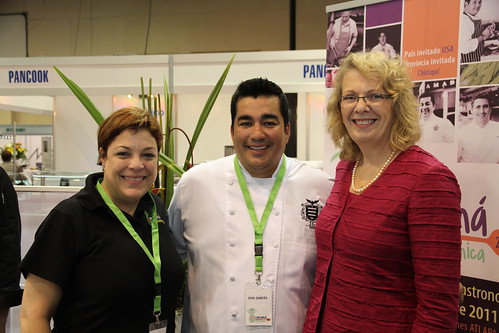
The U.S.-Panama Trade Promotion Agreement now awaiting Congressional action promises to boost U.S. exports to the nation known as “The Crossroads of the Americas.” In total, Congressional ratification of the Panama, Colombia and South Korea trade agreements will help farmers and ranchers add more than $2.3 billion a year to the American economy, which will support nearly 20,000 jobs. In Panama, USDA is hard at work cultivating consumers’ tastes for high-quality U.S. food and agricultural products at events such as last month’s “Panama Gastronomica,” an international food show in Panama City.
USDA’s Foreign Agricultural Service (FAS) office in Panama organized a pavilion at the show, featuring U.S. products such as beef, grapes, wine and cheese. The participation of U.S. celebrity chefs, including “Iron Chef” José Garces, helped generate excitement among the culinary professionals and others in attendance. There is no question that ‘Grown in America’ products remain in high regard and high demand throughout the world.
Events such as Panama Gastronomica allow FAS to raise awareness of, and demand for, U.S. food products by showcasing their quality, variety and value in key markets around the world. Panama is already an important market for America’s farmers and ranchers. In 2010, sales of U.S. agricultural products to Panama topped $450 million and the United States provided 48 percent of Panama’s total agricultural imports. The U.S.-Panama trade agreement is expected to provide U.S. exporters with opportunities for an additional $46 million in annual sales of rice, corn, meats, dairy and processed foods, according to the latest analysis by USDA’s Economic Research Service.
Taken as a whole, the United States is in the midst of experiencing the three best years in our history in terms of agricultural exports, and passage of all three trade agreements will strengthen what has been a bright spot in the American economy. USDA recently forecast fiscal year 2011 and 2012 exports will reach a record $137 billion, $22 billion higher than the previous record set in 2008 and $28 billion above 2010. Strong agricultural exports contribute to the positive U.S. trade balance, create jobs, and boost economic growth.
The pending trade agreement with Panama will also help level the playing field for U.S. exporters in Panama. Right now, 99 percent of Panamanian agricultural products enter the U.S. market duty free, but less than 40 percent of U.S. products enter Panama duty-free. The agreement immediately eliminates duties on nearly 50 percent of current U.S. exports and gives the United States improved market access for many products that have been highly protected. In addition, the agreement will help the United States compete with Panama’s other trading partners. Panama finalized its free trade agreement with Canada in 2010 and also has agreements in place with Chile, Costa Rica, El Salvador, Guatemala, Honduras, Nicaragua, Singapore and Taiwan. Panama is also negotiating a new free trade agreement with Colombia and considering negotiations with Korea, India and Peru.
For more information about the U.S. Panama Trade Promotion Agreement and its impact on U.S. agriculture, visit our website.
